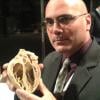
An optical coherence tomography (OCT) image of an Absorb bioresorbable stent. The stent struts are clear, allowing light to pass through, and in some cases magnifying the light that passes through under each strut. Image courtesy of St. Jude Medical.
There was an explosion of interest in bioresorbable stents immediately following the July 5, 2016 announcement that the U.S. Food and Drug Administration (FDA) had cleared the first fully bioresorbable coronary stent for the U.S. market. The Abbott Absorb is a first-of-its-kind medical device commercially available to treat U.S. patients with coronary artery disease. It completely dissolves in about three years, leaving nothing behind except for the tiny radiopaque markers that denote the ends of the stent on angiography. I saw first-hand the euphoria that this news brought in the medical community, many viewing the news similar to the first moon landing in terms of technological achievement.
The DAIC article announcing the FDA approval had more website page views in the course of a couple days than the next 10 most popular 2016 DAIC articles combined since January. On social media we saw this story shared an astronomical number of times. We also saw a massive traffic boost for all our archive articles and videos about bioresorbable stent technology. Any articles posted since the FDA approval that use the word “bioresorbable” also see immediate spikes in traffic.
Monitoring social media comments on the story showed an incredible interest in the topic by both U.S.-based and international cardiologists, cath lab nurses and techs. Many boasted about their lab's involvement in the ABSORB trials, or how they were going to be the first in their region to implant an Absorb stent post-FDA approval. Others seemed to be clamoring for more information about the new technology.
Despite the Absorb having been available for a few years overseas, international interest in the FDA clearance boomed as well, based on the locations of people accessing our content. I believe this is because an FDA approval of a new technology is only achieved after proving safety AND efficacy. This is unlike European CE mark approval, which is aimed at proving a device is safe to implant in a patient, not necessarily that it works well.
However, in the modern era of basing patient care decisions on hard clinical data, this enthusiasm should be tempered. The Absorb bioresorbable stent technology is a first step toward a new shift in care, not an end in itself. It is comparable to the first introduction of balloon angioplasty without stents, or the first drug-eluting stent that had its own faults and limitations. One of the big news items about the technology from TCT 2015 and ACC 2016 were data presentations on the limitations of the Absorb. These include poorer outcomes compared to metallic stents in vessels smaller than 2.5 mm; its very thick struts making it less agile or undeliverable in tortuous vessels; the difficulty in visualizing the stent on angiography; and the need to be much more precise in lumen measurements and stent sizing because the stent will fracture if overinflated.
Imaging of bioresorbable stents during delivery and proper vessel sizing will be the biggest challenges for novice users, so we are highlighting the article “Role of Imaging in Bioresorbable Stent Procedures” in the Sept-Oct issue of DAIC.
Additional information on the new Absorb stent users should be aware of can be found in my video interview with Dr. Gregg Stone at ACC.16, where he presented data on poor outcomes for bioresorbable stents in small coronary arteries. Watch the video at http://bit.ly/1qpTcgn
The article “Questions Remain on Future of Bioresorbable Stents” also offers more information on the limits of the Absorb’s current technology.
(UPDATE: read the Sept. 8, 2017 article "Abbott Will End Sales of Absorb Bioresorbable Stent")



 March 17, 2025
March 17, 2025 








